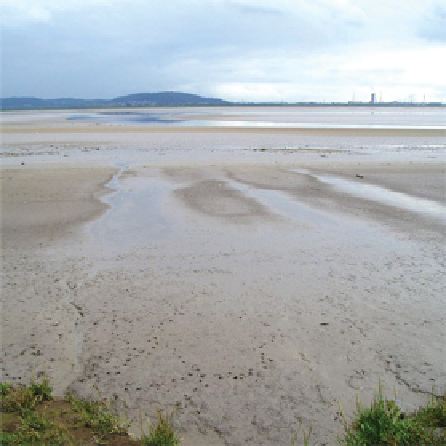Environmental Engineering Reference
In-Depth Information
as bioindicators of environmental change (Bortone,
2005) in these highly complex aquatic systems.
and Kromkamp, 1999). In addition, minor drainage
channels also discharge freshwater into the mud-
flats/main channel (Fig. 3.8) and freshwater/saline
wetlands are also frequently associated with the main
estuarine system.
In many estuaries, water from the catchment area
also has a major influence on the local marine envi-
ronment, flowing as a freshwater plume into the sur-
rounding ocean.
3.5.1 Ecosystem complexity
Estuaries are highly complex ecosystems in relation
to habitats, hydrology, effects of weather, constituent
organisms and human activity.
Habitats
Hydrology
Estuaries can be divided into two main regions - a
central river drainage channel (or channels) and a
surrounding expanse of mudflats (Fig. 3.8). Major
populations of phytoplankton are present within
the drainage channel, and an extensive biofilm of
euglenoids, diatoms and filamentous blue-greens can
occur across the surface of the mudflats (Underwood
Patterns of water circulation are complex. Water
movements within the main channel depend on input
from the sea (tidal currents), river (freshwater dis-
charge), surface drainage and ground sources (fresh-
water discharge). Mixing of freshwater and saltwater
within the main channel results in an intermediate
zone of brackish water - the 'salt wedge', where
dense sea water underlies an upper freshwater layer.
The salt wedge is a permanent feature that moves
up and down the main channel with advancing and
receding tide. Periodic movement water out of the
estuary into the surrounding ocean leads to a plume
of fresh or brackish water in the bay area.
Weather
Estuaries are markedly affected by local weather
events such as droughts, high rainfall (flooding) and
winds. During the autumn of 1999, for example,
hurricanes inundated North Carolina (USA) with as
much as 1 m of rainfall, causing a major flood in
the watershed of Pimlico Sound (Paerl
et al
., 2005).
Sediment and nutrient-laden water displaced more
than 80% of the Sound's volume, depressed salinity
by
70% and accounted for half the annual load of
nitrogen in this N-sensitive region.
>
Figure 3.8
View across the Mersey Estuary (UK) at
low tide, showing the extensive mudflats with main river
channel in the distance. Freshwater drainage into the
mudflats (foreground), with saltwater flooding at high
tides, leads to complex localised variations in salinity and
nutrient concentrations. Some epipelic diatoms (present
in surface biofilms) have wide tolerances to variations
in water quality while others have clear environmental
preferences (see text).
Estuarine organisms
Many algae living in or around estuaries are typically
adapted to either freshwater or saline conditions and
have restricted habitats (e.g. Section 3.3 - diatoms
in coastal wetlands). Other estuarine organisms have
become tolerant of a range of conditions. Diurnal and
seasonal changes in tidal flow mean that planktonic

Search WWH ::

Custom Search